Ebb Tide: Recovery From the 1997 Flood in the Red River Valley
An Exhibit Prepared by Students at Minnesota State University Moorhead, with the Assistance of the Northwest Minnesota Historical Center, the Lake Agassiz Regional Library System and the Minnesota Humanities Commission.
In April 1997 the Red River of the North, which marks the border between North Dakota and northwest Minnesota, flooded. The rivers and creeks that fed the Red also overflowed their normal channels, and the result of this flooding was a disaster of historic proportions. The immediate effects of the flood in the Red River Valley were easy to see – communities evacuated, homes pushed off their foundations by rushing water, cars literally floating. After the flood waters receded, the signs of disrupted lives were also in evidence as people carried ruined possessions out of their homes, stood in lines to obtain fresh, bottled water, studied bulletin boards to try and learn where friends and loved ones were now.
The immediate effects of the flood have been fairly well documented. But now, more than a year after the event, the ongoing work to rebuild and recover from the flood still dominates the lives of thousands. This exhibit attempts to show not only the physical recovery of the Red River Valley, but also the emotional recovery of those who were affected by the flooding. Through interviews, documents and photographs we hope to show that the flood did not end when the water receded. Rather, this was only the beginning of a long and intensive recovery process, a process that in some cases will never end.
The materials in this exhibit are part of the Center's collection of materials on recovery from the flood. For a more detailed description of this collection, see The Flood of 1997 in the Red River Valley: A Guide to Records Concerning Recovery from the Flood.
See a photograph from the Center's collections, showing an oil painting of the 1897 flood in the Red River Valley.
Background to the Exhibit
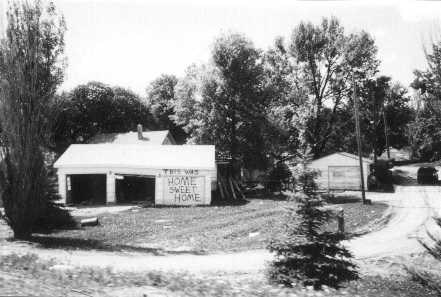
Abandoned home near the Red River, East Grand Forks, Minnesota, May, 1997.
The Flood of 1997 had an impact on the entire Red River Valley with over 150,000 people suffering directly from the flood. Thus, a comprehensive project on flood recovery would be impossible. Therefore, the exhibit concentrates on several broad themes of recovery: the impact on housing, income, and emotions; how specific communities have tried to recover from the flood; the role of government in recovery efforts; and prospects for future flood prevention. In an effort to gather information on these themes, the staff of the Northwest Minnesota Historical Center conducted interviews with community leaders, business owners, homeowners, and families in the Valley. Interviews were also conducted with farmers in the outlying areas of these towns and various officials whose responsibilities were not limited to one municipality. Quotes from these interviews have been incorporated in the exhibit boards in order to better explain the documents and photographs.
Elements of Recovery
During the weeks of sandbagging, as walls went up around buildings and walls between individuals came crashing down, the camaraderie and hope that was built up reinforced community ties throughout the region. After the waters receded, the process of tearing down the sandbags and rebuilding the physical aspects of community began. Though the days of sandbagging had seemed endless, the Red River Valley soon realized that the days of recovery would be much longer and, at times, even more stressful.
At this time there are still those throughout the region who have not yet rebuilt their homes or businesses. Some never will. In May of 1998, East Grand Forks officials reluctantly admitted that their post-flood population had declined by 15%. A former resident, Mary Anne Dunlevy, said that she could not face the "months and months" of strain that would have been necessary to rebuild her home of some 30 years. She is now living in the Twin Cities in a condo "as far away from a river as I could find."
But recovery is not just about the rebuilding of homes and businesses. The infrastructure of entire communities had to be rebuilt. For example, the efforts of rural power co-ops and the Northern States Power Company to bring electricity back to these communities is thus documented. Water management is also a continuing recovery issue, including where to place new dikes and how to deal with water pollution throughout the region. Another issue concerning a large portion of this region's population is the recovery faced by farmers, and how the flood may have possibly accelerated the decline of small farms.
The role of government has been another critical element of the recovery process. Residents in the Valley have reacted with mixed feelings toward the activities of government in flood recovery. In this region, where individualism and taking care of one's own is a well-entrenched tradition, there is reluctance to accept too much government assistance. Yet the scale of this disaster has made increased assistance by government essential. And delays experienced when dealing with state and federal agencies have been particularly trying. There are cases where bureaucracy has been exceptionally fast in dealing with flood issues, as was the case with the opening of a new landfill for East Grand Forks. While this normally would take 6-8 months, the Minnesota Pollution Control Agency approved the site of a new landfill in two weeks. On the other hand, the delay in Congressional action on the Federal Flood Assistance Bill sparked great debate and ire in the Valley.
As this exhibit shows, few people ever completely recover from a disaster of this magnitude. While communities and lives can be rebuilt, they remain forever changed. As with most natural disasters, communities were brought together both during the initial emergency and during the long recovery process. Today all that remains of many homes and businesses are memories. And for those who have left, memories are all that remain of their former lives.
Webster’s Dictionary defines "recovery" as "the act of returning to a normal state." Certainly this definition applies to the flood recovery efforts; as one person who was interviewed put it, "I just want my regular life back." Sadly, recovery has proved to be very difficult in this sense, and it is safe to say that many men and women will never fully recover from the 1997 flood.
In a modern city, power is the lifeblood of existence. But even before the flooding began, some 96,000 homes and businesses in the Valley lost electricity when an early April storm downed thousands of power lines. Lost power meant flooded basements in many homes. After the flood, work crews replacing poles and lines became a common sight in the Valley.
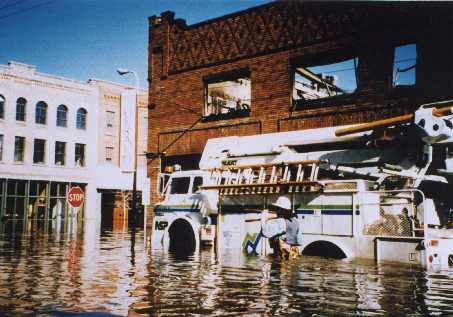
Flood waters hampered the work of company crews seeking to shut down water mains and electrical lines in Grand Forks. Photo courtesy of Northern States Power.
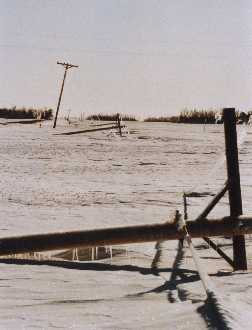
Downed power and telephone lines kept repair crews busy -- first in the cold and sub-zero wind-chill of March and early April, later in the heat of May and June. Photo courtesy of Red River Valley Co-operative Power Association.
Vice President Announces $2.2 Million FEMA Grant for Grand Forks Water Treatment Plant
WASHINGTON (February 24, 1998) - The Federal Emergency management Agency (FEMA) has awarded a grant worth more than $2.2 million in federal funds for construction upgrades that will protect the water treatment plant in Grand Forks, ND, from future flood disasters, Vice President Gore announced today.
"President Clinton and I are committed to ensuring that the families of Grand Forks do not have their critical water supplies shut off in the event of another catastrophic flood," the Vice President said. "Working together at the federal, state and local level, we will help all the families of North Dakota recover from last year's devastating disaster."
The funding, totaling $2,245,512, represents the 90 percent federal share of $2,495,013 in approved project costs. The funds were authorized under President Clinton's major disaster declaration issued on April 7, 1997, and made available through FEMA's assistance program for state and local governments.
According to the agency, the mitigation work is designed to protect the plant from a flood that exceeds the record flooding that struck the city last spring. The project will include flood-proofing work, elevation of monitoring devices and upgrades to basement equipment.
Completion of the project should enable the facility to operate independently for a period of up to two weeks during a major flooding event. Emergency supplies and fuel can be stored on site if floodwaters rise to a predetermined level.
The plant, which sustained more than $4.5 million in damage from last year's floods, is the city's main source of drinking water. Loss of the facility also affects other critical functions, such as the local hospital and the city's ability to fight fires.
Federal assistance permitted some communities to better protect water facilities against future flooding. Shown above is the FEMA news release announcing a grant to Grand Forks for upgrading its water treatment plant.
"We chlorinated it several times; but that didn't do it. Then we had professionals come out and clean the well, replace the pipes, screen, and everything, which was quite costly. That didn't do it, either. Finally, a person from the U.S. Public health looked at it and he found that the pipes that came into the house, up to the pressure tank, had been flooded and were filled with silt. So we were recontaminating the water as it came into the house. So we flushed out the pressure tank and finally got it clean."
Jon Evert, Clay County, on decontaminating his well. The Everts relied on water from family and neighbors for several weeks following the flood.
In the spring and summer of 1997, Valley residents coped with mountains of trash - everything from soaked furniture to ruined appliances to smashed heirlooms. In the Grand Forks-East Grand Forks area, Army Corps of Engineers trucks were used to haul hundreds of loads daily to land fills. City workers were putting in 12 hour shifts and seven day weeks until well into the summer in order to deal with the refuse.
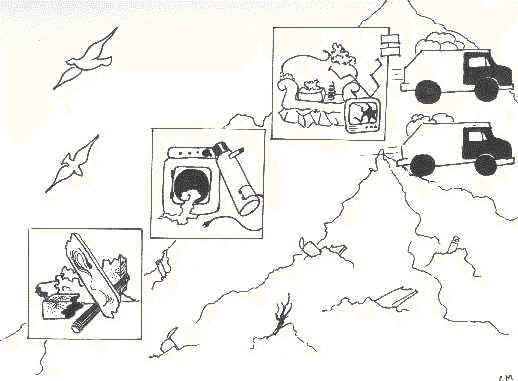
"To the Dump." Sketch by Carolyn Mahoney, Moorhead State University.
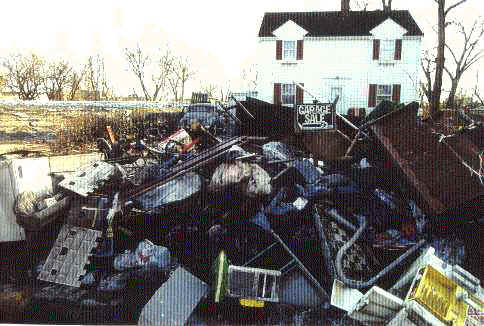
"Garage Sale." Such signs became a common form of graveyard humor in flooded neighborhoods. Photo courtesy of FEMA.
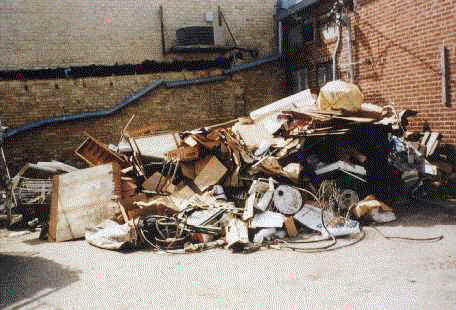
Trash piled outside the Ada police department headquarters, April, 1997. Photo courtesy of Greg Holmvik, Ada.
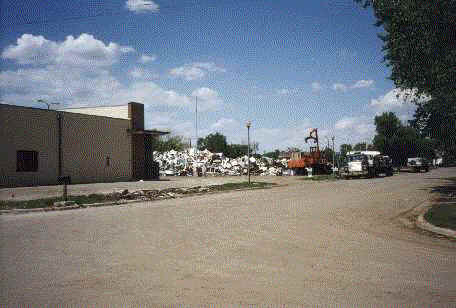
Hundreds of flooded washers, refrigerators, and other appliances stacked at a hauling site in Grand Forks, May, 1997. Photo from Northwest Minnesota Historical Center flood collection.
"We'd push things into a big pile, and then they'd haul it out, and then you'd clean a little bit more, and then they'd come back. I think they had about two or three pick-ups along the curb that way. About a week later they would come and pick up stuff again." - Craig Buckalew, on trash removal in East Grand Forks
One major frustration in the early summer of 1997 was the delay in passage of the federal government's flood relief bill. While senators and representatives of the region pleaded for faster action, and while the major political parties bickered over who was to blame for the delay, tired flood victims became increasingly angry and frustrated.
Sandbagged, June 5, 1997 Transcript
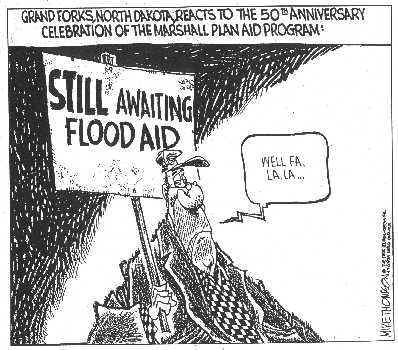
Political cartoon on flood aid frustrations. Courtesy of Copley News Service, June, 1997.
Political wrangling has held up much-needed disaster relief for the Midwest and other parts of the nation. In particular, the bill has been held up by amendments, objectionable to President Clinton, who says Republicans are putting politics above people's lives. Kwame Holman reports. Editor's note: This report was prepared before Congress passed the disaster relief measure Thursday night - with the amendments President Clinton objects to. He has vowed to veto the measure.
KWAME HOLMAN: Democrats from states recently hit by natural disasters returned from their 10- day Memorial Day recess this week all carrying the same message from their constituents.
SENATOR TOM DASCHLE, Minority Leader: The bottom line from South Dakotans, from Minnesotans, from North Dakotans, is that we need help. This is urgent. Congress needs to respond.
KWAME HOLMAN: Members of Congress had left Washington without finishing work on a five and a half billion dollar disaster relief bill. For North Dakota Democrat Earl Pomeroy, that was hard to explain to the people of Grand Forks.
REPRESENTATIVE EARL POMEROY, (D), North Dakota: At a neighborhood meeting in one of the flood-ravaged parts of town on Saturday morning, again and again I heard from individuals whose homes had been destroyed, "we are in the state of absolute limbo. How could Congress recess without doing anything?"
KWAME HOLMAN: The disaster aid makes up a lion's share of a so-called supplemental appropriations bill, money Congress must approve before it can be spent this fiscal year. Almost $2 billion for peacekeeping efforts in Bosnia and the Middle East is in there as well. But that money has been held up for weeks over a political fight, specifically two non-appropriation provisions added to the bill by Republicans.
"Sandbagged," a Public Broadcasting Service story on flood aid delay,
from PBS web page, June 5, 1997. President Bill Clinton did subsequently veto the relief measure after its passage, which led to the argument in the next item.
CNN Crossfire, June 10, 1997
BUCHANAN: Let me tell you something.....
CONRAD: There is not money for highways. There is not money for the school districts that have been affected.
BUCHANAN: There would be.
CONRAD: There is not money for the ranchers that have lost hundreds of thousands of head of cattle.
BUCHANAN: All right, let me talk to you....
CONRAD: None of those things are happening and a local official told me, by the way, the mayor, that if they say the pipeline is flowing, there must be concrete in the pipeline because the money is not getting through.
BUCHANAN: Now let me talk for a second. If your president had signed that bill, money would be flowing to the ranchers, money would be flowing for the highways, money would be flowing for the farmers and the only amendment he would have had to accept was look, we won't shut down the government in the fall and put all these people through hell. Why is your president being a selfish individual? Why doesn't he play the big man and say sure, I'll take that amendment, let's get that money up there to North Dakota?
CONRAD: The president didn't put unrelated matters in a disaster bill. I've been in the.....
BUCHANAN: Why didn't the president take the unrelated matters and say I'm a bigger man and do it?
PRESS: Let him answer, Pat. Let him answer.
CONRAD: Well, Pat, if you ask a question, give me the chance to answer.
BUCHANAN: Sure.
CONRAD: The president did not put unrelated matters in a disaster bill. The fact is this is holding up disaster relief. Now, the way we can resolve this is to have those who have strong feelings about the proposal of Senator McCain and other proposals, to offer them on other pieces of legislation. We could get an agreement. No filibuster. Straight up or down vote. And give the people who have been hit by disasters a chance to get their lives back in order.
BUCHANAN: Did you recommend to the president that he veto a bill which would have sent that aid to North Dakota?
CONRAD: No, I didn't recommend that he veto a bill, but I certainly understand his vetoing a bill that has, you know, in typically Congressional fashion, the old Christmas tree approach. Here comes a bill that everybody knows is going to become law, so let's everybody attach their own ornament. Let's everybody attach the thing that they care the most about to it, because they know that ultimately this is going to become law.
On the "Crossfire" syndicated television program, North Dakota Senator Kent Conrad and show's host Patrick Buchanan debate who is to blame for the delay in flood aid. Portion of Crossfire transcript of June 10, 1997 broadcast
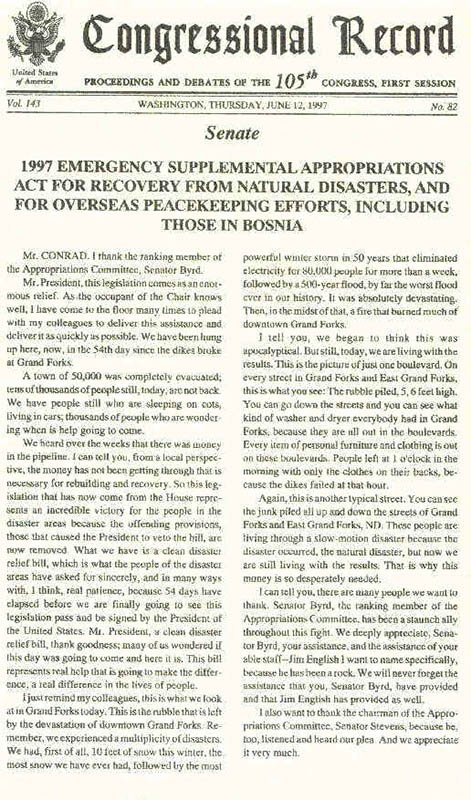
A statement by North Dakota Senator Kent Conrad on the delay in flood aid from the Congressional Record, June 9, 1997. Another relief bill was passed and signed into law soon after.
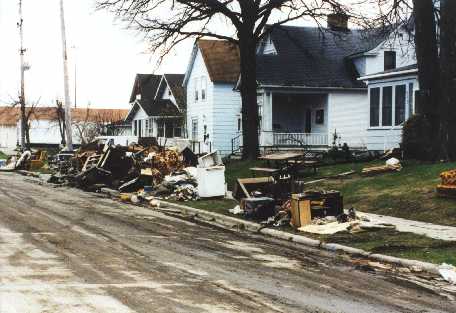
No one has been able to accurately estimate the loss of personal property from the flood. Homeowners' insurance, for example, seldom covered all that a person might lose in a bank's flooded safe deposit vault. Nor could money extinguish the anguish of losing mementos, photographs, or other items that could not be replaced. (Photo courtesy of FEMA)
Beware of Buying a Flooded Car
Buyer beware! Submerged cars, like this one in East Grand Forks, may turn up for sale.
The spring floods that hit not only Minnesota, but many midwestern states, makes it likely some flood-damaged vehicles will end up being offered for sale in Minnesota.
Minnesota law regulates the sale of flood-damaged vehicles. If a late model vehicle (currently the 1992 model year and newer) has suffered damage exceeding 70 percent of its actual value, the seller is required to disclose the damage to the buyer on the vehicle's certificate of title at the time of sale.
How can you tell if a car has been damaged by water? Often electrical problems don't surface immediately. Instead, they lie dormant for a year or more until corrosion eats away at the affected parts and cause them to fail.
Following are some tips to help you determine if a car has been flood-damaged:
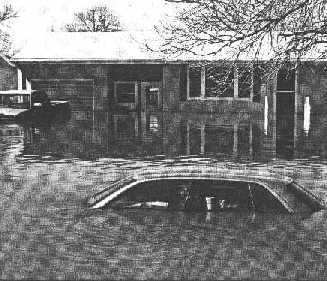
- Carefully examine the vehicle's interior and engine compartment for evidence of water and grit that may have resulted from submersion in water.
- Check for mud and grit in alternator crevices, behind wiring harnesses and around small recesses of starter motors, pumps and relays.
- Check under the dashboard for dried mud and residue, and look for any evidence of mold or musty odor in the upholstery, carpet or trunk.
- Inspect the undercarriage for any evidence of rust or flaking material.
- Ask to see the vehicle's title. If a late model vehicle has been "totaled" (declared a total loss) and purchased by an insurance company for flood damage, the Minnesota title should bear the stamp "Flood Damaged."Consider contacting the Motor Vehicle Division of the Minnesota Department of Public Safety for assistance in running a title search. Your request must be made in person at the central office in St. Paul or by mail. You will need the vehicle's license plate number. Contact the department at (612) 296-6911.
- And, of course, ask the seller. If the seller indicates that the vehicle hasn't been flooded, request assurance in writing.
This FEMA warning concerning flooded vehicles was published in FEMA Recovery Times, June 3, 1997.
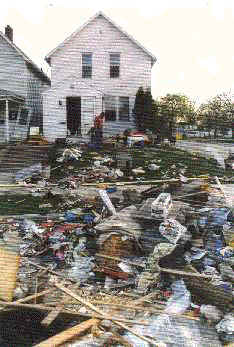
Dear FNBND Customer,
We are pleased that so many of you have come by to review the contents of your safe deposit boxes. We are also please that many of you have found the contents of the boxes to still be intact. For those of you who have not yet reviewed the contents of your box, we ask that you do so before June 14, 1997.
All safe deposit boxes that were located at our downtown facility are now at 2401 DeMers Avenue (the D & H Building) in Grand Forks. Please call (701) 775-8395 and schedule an appointment to view the contents of your box. We are scheduling appointments between the hours of 8:00 a.m. and 5:00 p.m., Monday through Friday. If items in your box were damaged by water, continued delay may make the damage worse.
When you come in to open your box, we will provide an inventory sheet. Please ensure you complete the inventory sheet to make it easier for you to submit claims to your insurer. We will also have cameras available to document any damage for your insurer.
If you find damaged items and, after submitting the claims to your homeowners' insurance, you still have amounts not covered, please let us know. There may be insurance available through the bank that would cover some of this unreimbursed damage. Please contact us before September 1, 1997, with any unreimbursed claims.
We thank you for your understanding. By working together, we can build a better community from this tragedy.
Sincerely,
Randy Newman
President and CEO FNBND
Vice President FNCND
(701) 795-3317 or 1-800-279-3200
First National Bank North Dakota contacted customers concerning the contents of safe deposit boxes at their downtown Grand Forks building. Although some customers had personal property insurance, many lost irreplaceable items. Letter courtesy of First National Bank North Dakota.
"I have a good friend, she's just staying in bed all day long. I call her at ten o'clock, and I say, 'Hey, get up, get doing, do something.' [She'll say] 'Well, I want my life back the way it was.' Well, it's not going to be the way it was; [she should] just make a new one. The way the flood has changed me as a person, I would say, is that I put a lot less value on personal belongings and possessions. It isn't that I think they're just totally unnecessary, but they sure have lost their meaning. When someone just hauls everything you own, practically, out to the berm, and you look at it - in fact, when I look back at pictures now, and I see other little things I forgot even were taken out there, it's all gone. It's been hauled away. You just kind of realize that, I guess, you can live without that." - Mary Ann Dunlevy, former resident of East Grand Forks, speaking in October, 1997.
Some of the most memorable images of the flood's aftermath were the piles of ruined personal property that lined the boulevards of Valley streets. So much trash was created by the flood that a year's worth could be hauled to landfills in a matter of days.
Of greater concern, perhaps, is what impact the pollutants in the flood waters may have on future health and the cost of personal health in the area.
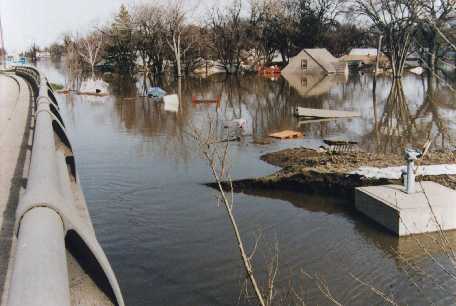
Flood waters, filled with every conceivable object and chemical, in East Grand Forks. Photo courtesy of Dave Saville and FEMA.
Flood Incident Response Mission Statement and Long Term Flood Recovery Work Plan for the Red River of the North Basin
Minnesota Pollution Control Agency - May 15, 1997
Prepared by Jack Frederick, MPCA, Northwest Regional Office in cooperation with the staff of both the Northwest Regional Office and St. Paul Office of the MPCA
Mission Statement
The mission of this work plan is to facilitate flood recovery within the Red River of the North basin within the scope of the Minnesota Pollution Control Agency's (MPCA) mission. The purpose of the work plan is to institute a transition within the agency from the MPCA's flood related emergency response activities to long term recovery (LTR) activities. The first phase in this transition has been targeted for completion by August 31, 1997.
Introduction
Flooding in the spring of 1997 reached unprecedented proportions exceeding 100 year flood event predictions throughout the Red River Valley. In response to this basin wide incident, the Minnesota Pollution Control Agency's Northwest Regional Office devised a plan in order to effectively and efficiently respond to environmental emergencies throughout the basin as they arose due to the record flooding.
In early April Peder Larson, commissioner of the MPCA, authorized that the Northwest Regional Office prepare and initiate an agency response action regarding this basin wide flooding crisis. Jeff Lewis (NW Regional Office Manager), Jim Ziegler (NW Regional Office Supervisor) and Walt Haas (NW Regional Office Emergency Response Coordinator) devised an emergency response structure for the region which divided the basin into zones and maximized utilization of both regional and central office MPCA staff and resources. A map and chart is attached which identifies the response zone alignments and the agency's flood response command structure.
As Incident Commander, Walt Haas, was given primary authority for insuring that staff was available to address all environmental issues that might arise during the course of this unprecedented flooding event within the basin. The primary focus by agency staff originally was: 1) the containment and removal of fuel oil products from homes and businesses; 2) the proper disposal of debris generated from the flooding; 3) the separation of household, commercial, and agricultural hazardous wastes from other solid waste streams and their appropriate treatment and/or disposal; 4) and the tracking, assessment of impacts, and provision for providing technical assistance to municipal and industrial wastewater facilities within the basin that were affected by the flooding.
East Grand Forks required a new land fill after its in-use site was flooded. The Minnesota Pollution Control Agency approved a new site in less than a month.
Ada Residents Deal with Aftermath
Water-damaged belongings are piled up outside of an Ada home as the owner gets an early start on repairs. Many town residents are returning home to find out that their problems are far from over.
Ada, MN - The stench of fuel oil thickens the air and coats the throat at Verona Heiraas' house in Ada. Last weekend's flash flood ruptured a tank and filled her house with 200 gallons of fuel oil. "The basement's plumb full," said daughter Angie Babler, who was tending Heiraas' house Friday afternoon. "You come out of here, and you stink."
That was just one of the unpleasant surprises waiting for Ada residents returning home to begin cleaning up. Most found basements filled with water, some up to the rafters. Front doors were flung open throughout town to let hoses crawl down the steps and releases gallons and gallons of water. The hoses were kept company by red plastic gas cans to fuel pumps since the city still had no electricity Friday afternoon.
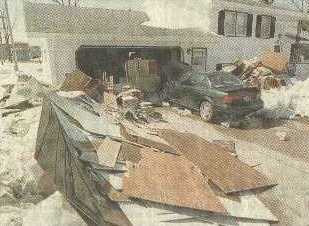
At Lowell Thompson's house, an ancient wood ironing board and a stack of ice chunks propped up a hose gushing water for four hours. Not that Thompson even knew what was going on at his house. Others stepped forward to help because his hands were full with his job at the city's public works department. "He hasn't even been over to his own house, and we said we were coming next door anyway," resident Mark Anderson said.
Their friend may regret coming home once he sees his basement. The water buoyed and tossed two huge freezer chests on their sides, spilling food across the floor. Bookshelves were heaved, and boxes and clothes were scattered in the rush of water. Other homeowners already had pitched soaked belongings into their icy yards. One already had stripped the basement down to sheetrock and 2-by-4's.
But the flood devastated businesses as well. More than 160 cars were ruined by the frozen flooding at Lee Bros. and Berby Ford, two of the city's three car dealerships. "They're totaled. There's water in every car," said Milt Lee, who owns Lee Bros. Sales. Lee cautioned residents with flooded cars to not start or move the vehicles. He recommended they call their dealerships, mechanics or insurance agents first.
The third dealership, Kelly's Chrysler Center, had 100 undamaged cars, which will be shared between the three businesses as loaners and rentals, Lee said. Lee Bros. service department was cleaned up and ready for repairs as soon as electricity returned, he said.
At the corner of highways 9 and 200, Ada Feed and Seed lost more than $400,000 worth of fertilizer and sunflowers stored in 10 Quonsets, owner Rick Wagner said. He got electricity at home Thursday night - only because he lives above the Ada Police Department. "I had my first shower in five days last night. Oh, felt good," he said.
Ada residents were among the first to feel the discomforts of cleaning flooded basements. Story from the Fargo Forum, April 12, 1997.
Hazardous Material
Within Manitoba, more than 550 containers that held or may have held hazardous materials before being swept into the floodwaters were retrieved from the Red River. These included propane cylinders and home heating fuel tanks. A total of 40 containers with some contents were also collected between Wahpeton, North Dakota, and the international border. The contents of these containers were wide-ranging: petroleum products, fire-fighting foam, tar, alcohol, solvents, corrosive liquids, polyester resin, flammable liquid, paint, pesticides, compressed gases such as propane, and home heating fuel.
Home heating fuel tanks were a source of hazardous materials in Grand Forks, where approximately 1,000 of the flooded homes used heating oil. During the flood, many of these tanks broke free from their connections and spilled fuel oil. After the flood, heating-oil-contaminated water was removed by vacuum trucks from 726 flooded homes and businesses in Grand Forks and separated. The water was discharged into the Grand Forks sanitary sewer system while the oil was recycled.
Estimates of the number of residential fuel oil tanks that spilled in Manitoba are not available. However, 56 home heating tanks were retrieved from the Red River within Manitoba. Other petroleum products were also lost. For example, approximately 15,000 gallons (68,100 liters) of gasoline spilled from service stations in Breckenridge, Minnesota. Several petroleum components were detected in water samples collected in the U. S. portions of the basin.
Cleanup after the flood revealed a plethora of household hazardous wastes, such as paint, pesticides, oil, solvents, aerosols, water putty, detergents, tar and batteries, in flooded basements. In the United States alone, excluding Grand Forks, 86 barrels of household waste were removed from flooded areas.
Part of a report from the International Joint Commission's Red River Basin Task Force, December, 1997. Canadian claims for damages due to American-made chemicals in the Red River are still being negotiated.
"What with all the molds that got into people's homes and air ducts after the flood, I'm sure that insurance companies are wondering what these will contribute to lung problems in the future, and what that will do to health care costs." - Lincoln Huseby, independent insurance agent, Fargo
Children's reactions to the flood were especially poignant. In pictures, poems, stories - even facial expressions - they reflected fatigue and bewilderment over the endless tasks of rebuilding lives after the flood. Below are two poems by students at Lincoln Elementary School, Grand Forks, ND, published in A Flood of Memories, November, 1997.
April Flood

I touched a Lincoln School brick.
I felt sad.
I was sad when all my animals
were lost in the flood.
I lost a teddy bear I got from my dad.
I was happy because I had somewhere to stay -
at my dad's in Mayville.
I got to play with Alison. We rode bikes together.
I saw a teddy bear floating in the water.
It was covered with mud and
it looked soggy and wet.
I head lots of people crying.
They sounded really sad.
I smelled my house.
It smelled like mud and rotten food.
I tasted spaghetti at my dad's house in Mayville.
It tasted good.
Audrey Dakken, grade 2
Flood Poem
I am mad at the flood because it
snatched half the summer from me.
It turned some of my things into useless garbage.
Before the flood,
my parents freaked trying to get
everything out of the basement.
The day we were evacuated,
I was a little excited because I knew we were going to Kansas to stay with my parents' families.
When I got back,
I was upset because the summer was half gone,
and I had to work harder
to get our house back to normal.
Ben Blake, grade 6

A child's view of the flood, from the Village Family Service Center's publication One Year Has Passed, April, 1998.
"We started serving her children in April while they were sandbagging...She's got 3 children, her youngest in April was 7 weeks old. She'd drop them off [at the Family Service Center], she'd go out and sandbag and about 6 hours later she'd come, breast-feed him, go back out and sandbag. And she did this for a week because they were trying to save their home. All they got out of their home was their grand piano." - Mary Barrett, East Grand Forks Head Start director.
For many weeks after the flood, the Tri-Valley Family Service Center provided child care in East Grand Forks -- virtually all of the city's home day cares had been flooded. Quote from Community in Crisis, December, 1997
Ada, Minnesota, was among the first communities to feel the flood's horrors. Ada's homes, businesses, and public buildings were all damaged, and most of the town's residents were evacuated in the first flooding in early April. Seven months after the flood, Ada's recovery was proceeding. But its residents' efforts to resume normal lives had been hampered by a wet summer. And, like most everyone else in the Valley, they worried about what the next winter would bring.
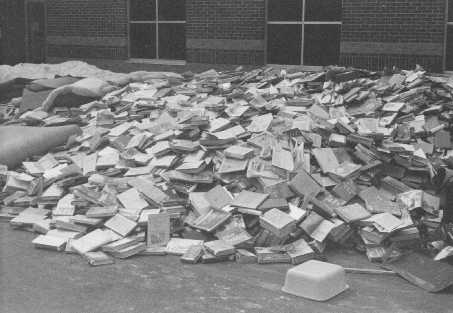
The Ada Public Library lost its entire collection to the flood. Above photo courtesy of Norman County Index.
Lake Agassiz Regional Library
118 South 5th Street
Moorhead, MN 56560
218-233-3757
TO: Ray Klein, FEMA representative
FROM: Deborah Janzen, Head of Technical Services
DATE: 1 July 1997
RE: Replacement costs for Ada Library materials
The information you request is below. I have attached a copy of the form used for replacing lost or damaged materials from Lake Agassiz Regional Library.
| Type of Material | # of Copies | Cost | Total |
|---|---|---|---|
| Adult Hardcover Books | 5863 | $24.00 | $140712 |
| Adult Paperback Books | 2253 | 8.00 | 18024 |
| Children's Hardcover Books | 5101 | 16.00 | 81616 |
| Children's Paperback Books | 1072 | 8.00 | 8576 |
| Audio cassettes | 481 | 10.00 | 4810 |
| Video cassettes | 29 | 24.00 | 696 |
| Reference | 436 | 10260 | |
| TOTAL | $264694 |
The prices for the reference materials were verified in Books in Print. The variance in the initial replacement costs and the listed here is using specific costs for reference materials, not a standardized cost. If you have any questions on this information, please call me.
Eventually, the library collection was replaced through Federal grants and hundreds of contributions from around the nation. Above letter courtesy of Lake Agassiz Regional Library.
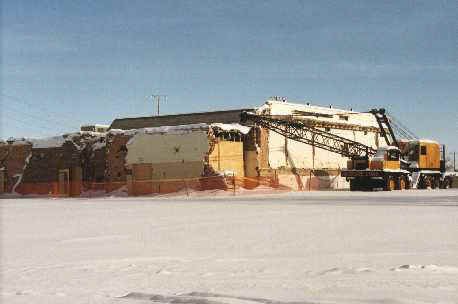
Ada high school demolition courtesy of Darel Paulson, Moorhead State University.
The Ada High School was too damaged by the flood to be restored. It was torn down during the winter of 1997-98, and a new high school was built on the west side of town.
State of Minnesota Department of Corrections State ICWC Program Income Contract
This contract is between the Tri-Valley Opportunity Council, Inc., address P.O. Box 607, 102 North Broadway, Crookston, Minnesota 56716, (hereafter "TVOCI") and the STATE OF MINNESOTA, acting through its DEPARTMENT OF CORRECTIONS (hereafter "STATE").
WHEREAS, the TVOCI has determined that it ha a need for an Inmate Community Work Crew (ICWC); and WHEREAS, the STATE operates a ICWC program:
NOW, THEREFORE, it is agreed:
I. DUTIES OF STATE The STATE shall:
- A. Provide crewleader(s) who will supervise up to 10 offender crew members each approximately 40 hours per week.
- B. In coordination with TVOCI representative, train each work crew in safety principles and techniques set forth by the TVOCI representative and applicable federal, state, and local agency requirements. TVOCI agrees that the STATE has the responsibility and authority to refuse selected projects if it considers the projects beyond the skill level of the crew members and/or unsafe to perform.
- C. Provide required personal safety equipment and clothing needed for specific work.
- D. Screen projects to ensure that they meet ICWC guidelines.
II. DUTIES OF TVOCI The TVOCI shall:
- A. TVOCI shall obtain the proper permits, licenses or special authority for TVOCI work projects.
- B. TVOCI Housing Development Specialist, Brian Halos, or another person named by the agency shall assign all work and coordinate materials and projects that must be performed by the STATE.
- C. TVOCI Housing Development Specialist, Brian Halos, or another representative named by the agency shall meet with the STATE as necessary to coordinated training and provide project information needed by the STATE in the performance of their duties.
III. CONSIDERATION AND TERMS OF PAYMENT
- A. Consideration for all services performed and goods or materials supplied by the STATE pursuant to this contract shall be paid by TVOCI as follows:
- 1. Pay the STATE an amount not to exceed $60,667.00 during the term of this agreement. Pursuant to this agreement and before any work is done, TVOCI shall pay to the STATE $4,333.33 and pay $4,333.33 on a monthly basis commencing June 1, 1998 through June 1, 1999; and in addition,
- 2. Pay the state for actual cost of inmate labor in a manner consistent with the pay plan for this program (Attachment A) which shall not exceed $1.60 per hour per inmate.
- B. Terms of Payment. Payment shall be made by the TVOCI within 30 days of receipt of invoice.
IV. TERM OF CONTRACT. This contract shall be effective on May 1, 1998, or upon the date that the final required signature is obtained by the STATE, pursuant to MN Stat. 16B.06, subd. 2, whichever occurs later, and shall remain in effect until June 30, 1999, or until all obligations set forth in this contract have been satisfactory fulfilled, whichever occurs first.
The Tri-Valley Opportunity Council (TVOCI) negotiated a contract with the Minnesota Department of Corrections to use prisoner labor to rebuild damaged homes in Ada. Contract courtesy of Tri-Valley Opportunity Council.
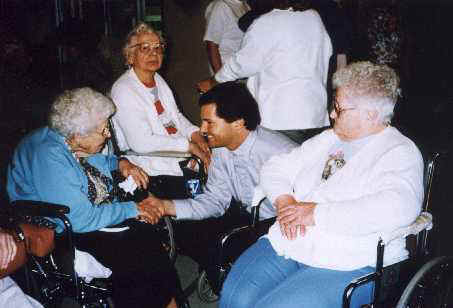
Photo courtesy of Brenda Wagner and John Wimmer Nursing Home.
Evacuated to other nursing homes during the flood, the residents of the John Wimmer Nursing Home in Ada still wait for the day the Wimmer Home is fully rebuilt. As of April, 1998, 24 of the 47 residents had passed away.
Loss of income plagued many after the flood. As these examples from the communities of Breckenridge and Wahpeton show, circumstance and chance had major influence on when and how a flooded business could resume its operations. Altogether, businesses, employers, and employees lost millions of dollars due to flood-related interruptions of normal business.
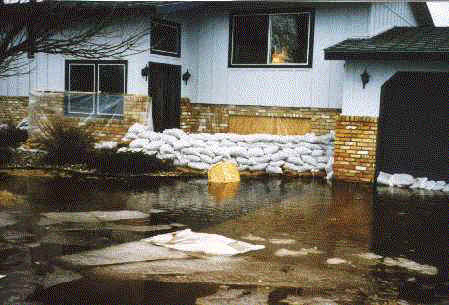
Photo courtesy of Randy and Nanci Tobias.
Even as the flood waters were still receding around his south Breckenridge home, contractor Randy Tobias was able to continue his business with a minimum loss of income. In the following months, flood repairs became a regular part of his work.
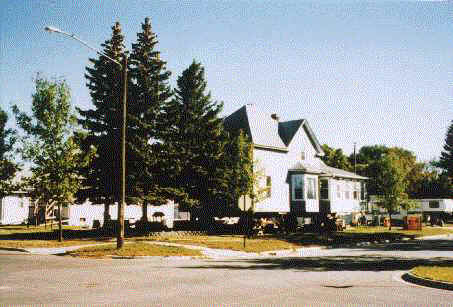
Photo courtesy of Kim Willemssen.
The Willemssen home in Breckenridge, lifted off its foundations to await a new basement.
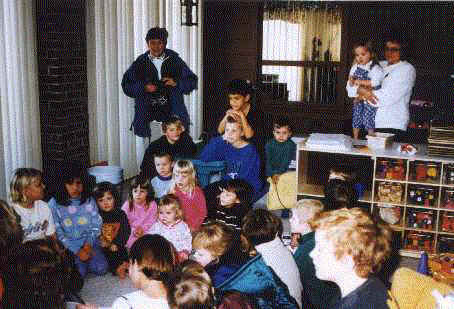
Photo courtesy of Kim Willemssen.
When the flood damage forced her to have her home lifted off its foundation, Kim Willemssen feared that she would have to stop her day care business. But two of her clients, Jeff and Paula Davis, offered the use of their home. At Christmas, 1997, a 3rd grade class from Wahpeton sings carols with Kim's day care children in the Davis family room.
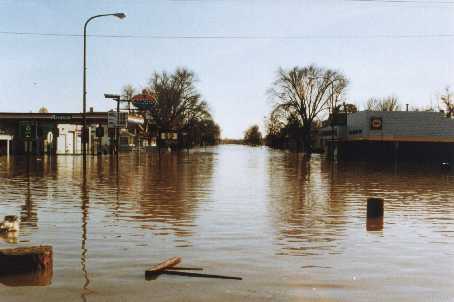
Photo courtesy of Dave Saville and FEMA.
After his NAPA Auto Parts store was flooded in Breckenridge, John Rightmire's business was closed for several months. Finally, he reopened in a new location in Wahpeton, North Dakota.
Flood of '97 took its toll on Breckenridge firms
By Gerry Gillmour, The Forum
Some closed, Some left. Most stayed. The flood of 1997 was especially tough on businesses here because it struck not once but twice in a city that each spring battles not one river but three. Today is the anniversary of the second record crest of the Red River at its headwaters.
"The thing that continues to blow my mind is how devastated this town was," says Stan Thurlow. Thurlow was hired in the wake of the flood as director of the city's new Office of Housing and Flood Recovery. He said the flood caused at least $50 million in damage to homes, businesses and city infrastructure, and estimates that the city lost nearly 10 percent of its population. "People forget how bad it was. But what happened at Grand Forks and East Grand Forks just took us off the national radar screen," Thurlow says. "To this day, people just don't have a clue about what happened here."
The flood of April 15 caught many off guard. Water came from not only the rivers but flowing overland into the south side of town. Everything south of the main railroad line and Minnesota Avenue was inundated with water. More than 20 businesses on the south side of town were closed for extended periods. Breckenridge Motors, the local auto dealership, never reopened. It consolidated with a Wahpeton, ND dealership. Four Seasons Plant Center, a local nursery just south of where the Bois de Sioux joins the Otter Tail to create the Red River of the North, essentially lost an entire year of business.
The local NAPA Auto Parts store, a 25-year fixture in the community, ended up moving to Wahpeton, relocating on the highway 210 bypass which links Breckenridge and Wahpeton on the north. "It doesn't really seem like we're open yet," says John Rightmire, Jr., who still works with his father, John Rightmire, Sr. "See all those parts over there? We have to put those away yet."
The Breckenridge NAPA was in an old grocery store building, just south of downtown and just south of the railroad tracks. It has been there since a downtown location burned in 1976. NAPA flooded at its grocery store location in 1989. Last year, its basement was flooded during the first Wahpeton- Breckenridge crest of 1.2 feet on April 5. The second crest left 2 feet of water on the main floor.
With encouragement and loans from NAPA, Rightmire decided to reopen. Unfortunately for Breckenridge, he ultimately decided on a flood-free location across the Red River. "We did try to find a Breckenridge location," Rightmire says. "It seemed like there were sites, and then there wasn't. We had to do something." The new 8,500-square-foot, $350,000 store and shop was built by one of Rightmire's drag racing buddies, Bill Weimann, owner of American Building Brokers of Fargo. "We've still kept our Breckenridge business, but we're getting a lot of new business here," Rightmire says. "We hope that continues."
Part of an article that appeared in the Fargo Forum, April 15, 1998:
"It's always nice to hear that there was a $250,000 loss and the business was fully insured, but it doesn't do much good if you have to wait to rebuild that business and you don't have any income coming in." - Lincoln Huseby, independent insurance agent, on business losses.
The costs of recovery are high, even in communities that experienced relatively minor flood damage. Compared to other towns in the Valley, Moorhead had little damage. Yet, the expenses of repairing dike, sewer, and street damage, together with other mitigation projects to reinforce city services against future floods, carry a price tag that exceeds four million dollars.
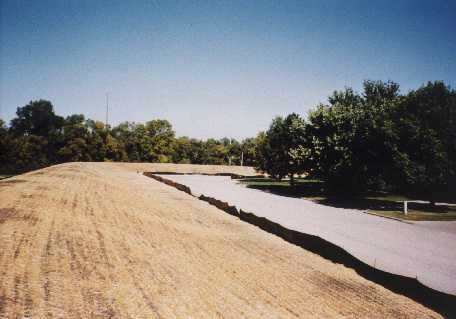
Photo courtesy of Moorhead Public Works Division.
Dikes in the Horn Park area, raised for better flood protection, August, 1998.
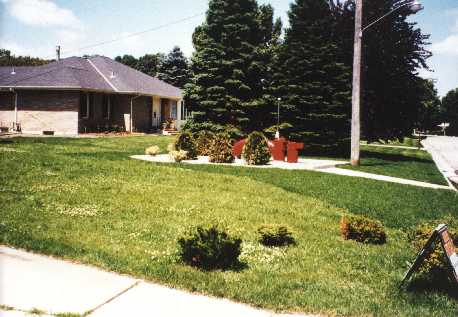
Photo courtesy of Moorhead Public Works Division.
Water control gates, installed to prevent flood waters from inundating the storm sewer system.

Moorhead's mitigation projects as outlined in the city's publication The Flood of 1997: Moorhead Recovers.
MITIGATION PROJECTS
- Construct manhole structures with control gates at two locations on the sanitary sewer system. Complete failure of these systems would have resulted in sewer back up in over 50% of the community.
- Construct manhole structures with water control gates at twelve locations on the storm sewer system. This will protect the sanitary sewer system from exfiltration of the storm sewer system.
- Increase the height of existing flood control levees at Horn Park and Woodlawn Park. The Woodlawn Park levee protects over 40 residences and the Horn Park levee protects over 50 residences, and both levees provide infrastructure protection for immediate and adjacent areas.
- Install concrete ditch liner and construct control structure in County Ditch 30. This will provide adequate drainage for over 1100 acres of residential and agricultural land.
- Install an earthen berm along County Road 7. The berm will deter water from backing up into the Village Green Golf course ponds and flooding area homes.
- Install chimney seals on sanitary sewer manholes. Chimney seals will reduce infiltration of storm water in to the sanitary system.
- Install isolation valves at houses in the 100-year flood plain. This will be the only method of preserving the sanitary system during major flooding events.
- Raise the lift stations in Oakport Township. Raising the lift stations will provide protection from high river levels and eliminate the need for sandbagging.
- Develop a computer program to provide property and river elevations to residents. This will allow property owners and city officials to be proactive in flood preparation measures.
TOTAL ESTIMATED COST: $4,385,00
The flood effectively made obsolete the street maps of many Valley communities. Homes, streets, even entire neighborhoods have disappeared since the waters receded. Whether the lost homes are victims of redefined flood plains or simply the fact that the owner could not afford to repair his or her house, the result was the same - what had been "home" for many years was gone.
EAST GRAND FORKS EDHA - New Construction Incentive Program
These programs are available to residents whose homes are acquired by the City of East Grand Forks and who want to rebuild in East Grand Forks. The income limit for both of the following loans will be $56,000. These loans are no-interest loans, forgiven if the homeowner lives in the home for ten years and repayable from sale proceeds if the home is sold before ten years.
Lot Incentive Loan - Residents who meet the income limit are eligible for a no-interest $7500 deferred loan toward the purchase of replacement lot within the city of East Grand Forks.
Affordability Gap Loan - Residents who meet the income limit will be eligible for an additional no-interest deferred loan up to $15,000 toward the purchase of a newly constructed home in East Grand Forks if there is a gap between the mortgage the household can qualify for and the total cost of the home. The maximum house price is $130,000, including land and special assessments.
The household must reinvest the proceeds from insurance and they buyout into the new property, must apply for an SBA loan, and must carry reasonable debt based on FHA underwriting standards.
For further information about these programs, call 218-773-8939.
East Grand Forks flyer concerning interest-free loans to residents who would replace their lost homes in the city. The flood sparked a construction boom in the Valley, and a competition among cities seeking to keep -- or gain -- residents.
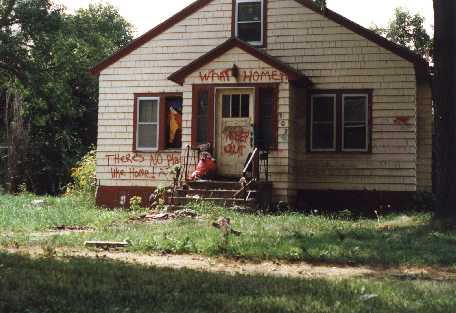
Photo from the Northwest Minnesota Historical Center flood collection.
The flooded home at 302 Lincoln Drive in Grand Forks awaits demolition -- the small cross on the lawn is marked "R.I.P. 302".
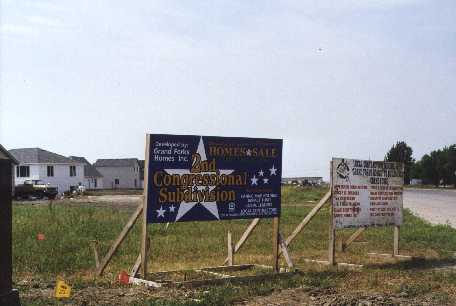
Photo from the Northwest Minnesota Historical Center flood collection.
Meanwhile, in the new "Congressional" subdivisions on the west side of the city, new homes are going up. At first, sales of the new homes were slower than expected, but after the city offered incentives to buyers, sales picked up in mid-1999.
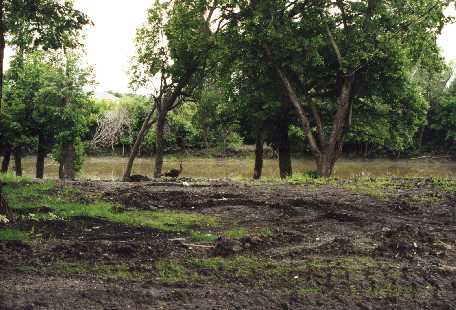
Photo from the Northwest Minnesota Historical Center flood collection.
In south Moorhead, several houses along River Haven Drive were flooded and removed to allow an extension of the diking system. Here, a wild turkey reclaims its habitat, standing on the filled foundation of a demolished home.
Deadline Set for Voluntary Buyout
For the past ten months, the city of Grand Forks has been buying flood-damaged homes to help residents move along on the road to recovery. The program is voluntary - residents don't have to take part if they choose not to. But the time they have to make that decision is running out. The Grand Forks City Council has approved an October 1, 1998 deadline for residents in the Phase I and Phase II buyout program. That means they have until October 1 to sign a purchase agreement with the city, or the offer from the city will be withdrawn. Phase I homes are those closest to the river that suffered the worst damage from the flood, while Phase II homes are located within the 100 year flood plain and suffered more than 50 percent damage. The city has not set a deadline for homes in Phase IA, Phase III or Phase IV.
To date, more than 525 flood damaged homes have been purchased by the city. "We think it's an effective way to deal with the problem," said Grand Forks Urban Development Director John O'Leary. "Without a voluntary buyout program, residents would get little or nothing for their property."
Community Development Block Grant funds are used to pay for the homes. Homeowners are offered the pre-flood value of their homes, regardless of the condition of the structure Everyone eligible for a Phase I or Phase II buyout was sent an offer several months ago. Residents had three options: they could accept, reject or appeal the offer. At the time, no deadline was mentioned, but council members felt it was time to bring that part of the Voluntary Buyout Program to a conclusion. "We need to put these phases of the recovery behind us," said Duane Hafner, chairman of the Flood Response Committee. "This should encourage residents to complete this part of their recovery that will allow them to get on with their lives."
The Grand Forks Public Information Center will be responsible for following up with residents who received buyout offers, but have yet to take any action. "We want to make sure residents have every opportunity to take advantage of the Voluntary Buyout Program, if they choose," said Kevin Dean, Public Information Officer. "Our office will help answer questions residents may have about the program, so they still have plenty of time to make an informed decision."
If you would like more information about the Voluntary Buyout Program, contact the Grand Forks Public Information Center at 746-2736. The office is open from 8 a.m. to 5 p.m. Mondays, Wednesdays and Fridays. On Tuesdays and Thursdays, the Public Information Center is open from 8 a.m. to 7 p.m.
From Recovery Road, published in Grand Forks, June 1998.
Like schools in Ada, Breckenridge, Grand Forks, and elsewhere, Oak Grove Lutheran School had to find another location for classes after the flood. Oak Grove students finished the school year at Concordia College while volunteers began restoring the campus in north Fargo. Classes resumed at Oak Grove for the 1997-98 school year.
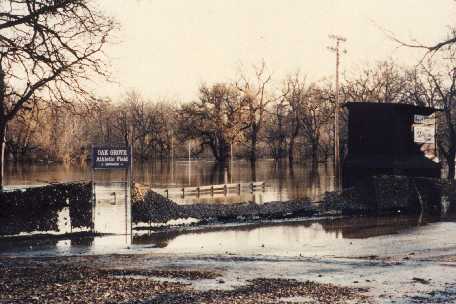
Photo courtesy of Marilyn Nielsen and Oak Grove Lutheran School.
Oak Grove's athletic field required complete restoration after the flood.
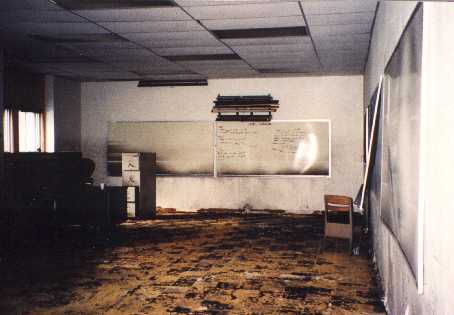
Photo courtesy of Marilyn Nielsen and Oak Grove Lutheran School.
A classroom in Jackson Hall, its flooring stripped prior to full repairs.
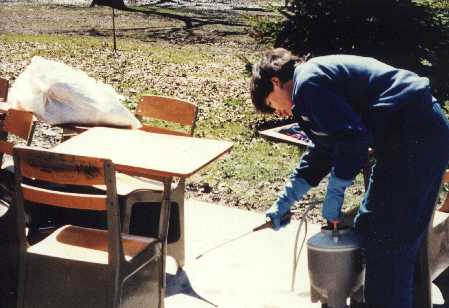
Photo courtesy of Marilyn Nielsen and Oak Grove Lutheran School.
A student decontaminates desks and other classroom furniture.
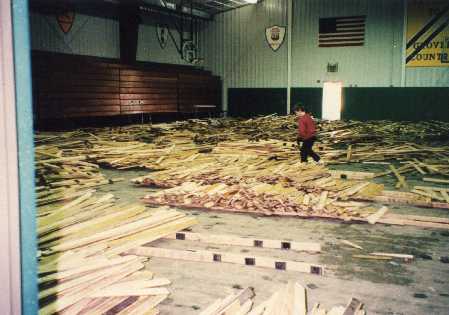
Photo courtesy of Marilyn Nielsen and Oak Grove Lutheran School.
While the school's gymnasium awaited a new floor -- requiring 10,000 feet of finished maple -- the Oak Grove basketball teams practiced in gyms at other schools and neighborhood churches.
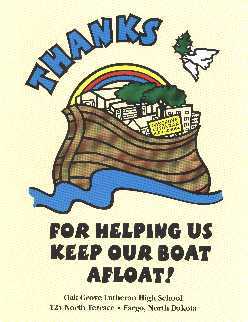
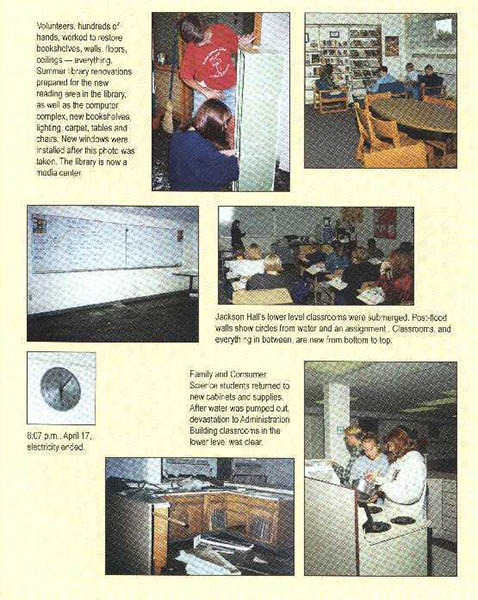
Brochure from Oak Grove Lutheran High School.
The Nora Lutheran Church near Gardner, North Dakota, had stood on its original site since 1913. But after the flood waters damaged the basement walls, it looked like the building might have to be demolished. After a concerted effort which involved raising funds from Lutheran churches and organizations across the nation, the Nora congregation was able to have the building moved 30 feet north and 4 feet higher on a new foundation. A new wing, to replace the basement, will be added before the year 2000.
LUTHERANS PERSEVERE IN RECOVERY WORK ALONG THE RED RIVER VALLEY 97-29-084 MR - October 16, 1997
CHICAGO (ELCA) - "I spent the first day of autumn breathing in dust and mold. There is dust in the air and a heavy smell of mold and mildew. But there is something else -- the sweet smell of fresh-cut lumber, the new smell of wallboard and spackling, the sounds of hammering and the words, 'thank you,'" said the Rev. Gilbert B. Furst, associate director, of the Evangelical Lutheran Church in America's Domestic Disaster Response.
The record snowfall and floods of the 1996-1997 winter and spring seasons caused catastrophic conditions along the Red River Valley. "The devastation was so incredible that recovery will be a long-time endeavor," said Julie K. Aageson, Nora Lutheran Church, Perley, MN, in an interview. "There is still such a sense of vulnerability among people because the floods were so devastating. People are afraid of the upcoming winter...there is fear that it could all happen again," said Aageson.
"There is so much yet to be done in northwestern Minnesota, North Dakota and South Dakota. The floods have receded in the Red River Valley, but thousands of homes still stand in need of repair," reported Furst. Furst visited rebuilding sites in Grand Forks, ND and East Grand Forks, MN, last month.
The Rev. Robert L. Dahl, Our Savior Lutheran Church, East Grand Forks, MN, told of 30 families in his congregation whose homes have been completely demolished. Most of these families have been living in trailer parks set up for flood victims since April. Others live in half destroyed homes, with basements still full of water.
"My husband and I volunteered at a congregation in which the foundation was completely destroyed," said Aageson. "The basement can no longer be used for fellowship and to teach Sunday School classes. Instead, the basement is now completely sealed off, so worship during the upcoming winter season can be warm. The church will need to be moved; the existing foundation is beyond repair," she said.
"The primary needs in our recovery efforts have not changed. They are prayers and cash," said the Rev. Rick J. Foss, bishop of the ELCA's Eastern North Dakota Synod. "But the need for volunteers has suddenly become the number one need. There are hundreds of homes that require skilled volunteers to help rebuild," he said.
(Press release from the Evangelical Lutheran Church of America, asking for assistance for the Nora Lutheran Church, October 17, 1997.)
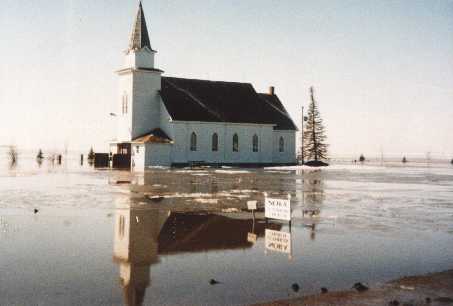
Photo courtesy of Nora Lutheran Church.
The Nora Lutheran Church in April, 1997.
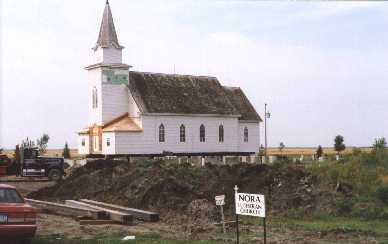
Photo from the Northwest Minnesota Historical Center flood collection.
The Nora Lutheran Church undergoing repairs in June, 1998.
Flood-Relief Volunteers are 'a Godsend for Us'
Lucille Malen, right, a Gardner, ND farming-community resident, hugs Marge Ockrassa, one of a number of St. Louis-area Lutherans who dove to North Dakota in June to help with flood cleanup work. The strip of cloth around Malen's arm was presented to her by Ockrassa after it was torn from the strip around Ockrassa's neck. That strip, in turn, was taken from a larger "sending cloth" hung on the alter of Concordia Lutheran church, Kirkwood, MO, at the time the cleanup team was "sent" to North Dakota. The sending cloth remained on the alter until the team's return as a symbol that the church was extending care and compassion to others.
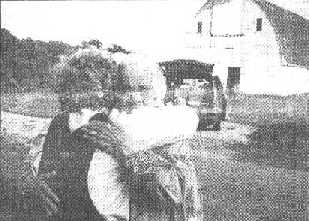
The stories that victims of natural disasters tell won't be about the cause or overall scope of the problem, or about how many dollars have been contributed toward relief work. Rather, the stories will be about loved ones lost, family albums destroyed, or years of heard work swept away. They will also be stories about the "wonderful people who help us."
"They have been a godsend for us," said Kelly Straub, a flooded-out Grand Forks, ND resident, speaking about Lutheran Social Services of North Dakota (LSS) staff and volunteers. LSS is the Lutheran agency coordinating Lutheran Disaster Response (LDR) work in that state. LDR is a cooperative effort of the Lutheran Church-Missouri Synod and the Evangelical Lutheran Church in America.
"FEMA (Federal Emergency Management Agency) was here. And, the Red Cross. They pulled out two weeks ago. The Salvation Army...we see them once in a blue moon. But, LSS has been fabulous. They've come by to visit. They brought us blankets. They stop by to see how we're doing," said Straub.
(Clipping from an unidentified St. Louis newspaper, on assistance sent by a church in Kirkwood, Missouri)
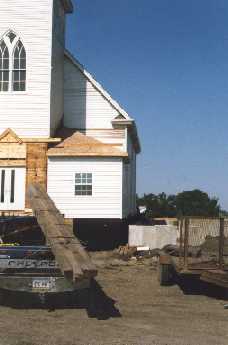
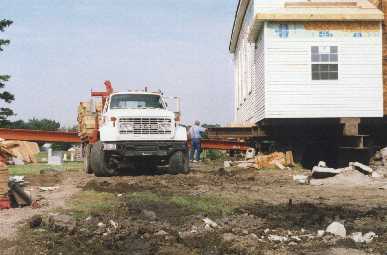
In July, 1998, the Nora Church was moved on to its new foundation, a process that required precise coordination of hydraulic lifts and steel beams. Photos from the Northwest Minnesota Historical Center flood collection.
Many farms were hard hit by the flood, with losses in equipment, livestock, and property amounting to hundreds of millions of dollars. Since the flood, small farmers have struggled with ongoing grain price problems, and have disagreed over how water management proposals put forward to deal with future flooding may affect their futures.
Overhaul of State Ditch 83 Divides Northwestern Minnesota Residents
by Leif Enger - November 18, 1997
Much of what we know as Minnesota's fertile farmland would still be swamp had it not been drained. A hundred years ago it was common practice to dig ditches and dredge rivers, and today those ditches and rivers keep the land arable. But conservationists say increasingly it's a practice out of sync with environmental biology; and a proposal for a major ditch overhaul in northwestern Minnesota has divided local residents.
The Rodahl place looks like most other flatland farms north of Thief River Falls: wide snowswept fields separated by banked roads and drainage ditches holding a few feet of rapidly freezing water. Darrold Rodahl himself is lean, about forty, with a face showing years of work in persistent winds.
Rodahl says, "We're looking at my barley field of about a hundred acres that drowned out, completely drowned out, the first few days of July. The water was unable to run out the 83 system because it's gone into such disrepair. It would not take the water from the field."
The problem Rodahl says, is State Ditch 83, also called the Thief River: it's clogged with beaver dams, silt, and trees that have grown up on its banks and fallen in. It takes a long time for spring runoff to run off; and if the ditch is full and the fields are soaked; a day's hard rain can work ruin. So last summer Rodahl and 15 of his neighbors signed a petition asking the Red Lake Watershed District to re-dredge Ditch 83. Speed up the water, rescue the farms.
Rodahl says, "Every drainage system needs repair sooner or later. It it doesn't happen, we stand to be flooded for more duration as the system continues to deteriorate. Our land will become less and less valuable to us. Without drainage, there is no value in it."
Drainage, farmers point out, is what turned this area from swamp to productive acreage in the first place. Starting in the late 1800s, massive ditching projects drained hundreds of thousands of acres. The ditches emptied into rivers, which carried runoff downstream. Sometimes the rivers themselves were dredged - deepened, their beds smoothed out - to carry more water...........
(A Minnesota Public Radio broadcast five months after the flood focused on drainage issues and disagreements between farmers and water management advocates)
Watershed district approves impoundment that might jeopardize flood-control project
By Jaime DeLage, Herald staff writer
WARREN, MN - City leaders here believe a decision by the Middle River-Snake River Watershed District could scuttle their chances of completing a proposed flood-control project.
Warren's flood-control project has been in the works for about 10 years. It comes in two parts: a 5-mile diversion to speed the Snake River around the south edge of town, and an upstream impoundment to trap river water during the peak of a flood.
Watershed District directors approved an impoundment plan Monday night. But 2.6 miles of abandoned river channel would be within the boundaries of the impoundment - a piece of real estate that could jeopardize approval of the entire project.
The Army Corps of Engineers, the Department of Natural Resources, and the Board of Water and Soil Resources are less likely to permit an impoundment including the river channel, said Dick Nelson, Warren's mayor. That throws the whole $14 million project into question. "With no permit, there's no funding," Nelson said.
Avoid the river
Nelson and the City Council wanted the Watershed District to approve basically the same impoundment, minus the abandoned river channel. The channel is an old section of the Snake River cut off by the railroad around the turn of the century.
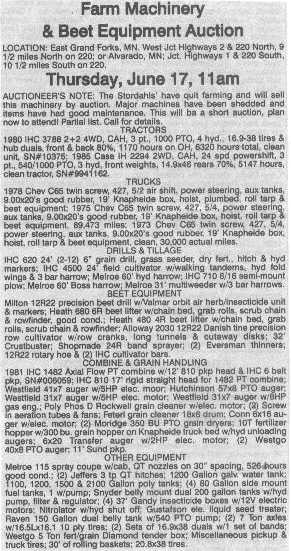
"They understood before going into that meeting what the consequences would be," Nelson said. "The flood-control project will not go through under the plan they have endorsed."
Half or more of the project would be paid for with federal funds. The Minnesota Department of Natural Resources would pay around 30 percent and the rest of the cost would fall upon the city and Watershed District.
District engineer Ron Adrian said he doesn't think the situation is as dire as city officials say. "Some people are suggesting this impoundment is not (permissible)," Adrian said. "I think the concerns can be worked out and I think they will be worked out. We're one of the sponsors. We want to get the project done and get it done in the best interest of the community."
The district directors want to include the river channel primarily to add more water storage. Without the 120 acres surrounding the river channel, the impoundment would store a maximum of about 6,700 acre-feet of flood water. Adding the river channel would increase storage by about 600 acre-feet, Adrian said.
Adrian will meet with representatives of the Corps and the DNR as soon as possible, he said, and he expects to get an opinion back from them within a week or two. One of those representatives, DNR hydrologist Nate Dalager, said the agencies probably won't let the impoundment swallow the old riverbed when it would work nearly as well without. "That option simply does not meet permitting criteria and would cost more money for a minimal amount more storage," Dalager said.
No big difference
Excluding the river channel from the impoundment would increase the flow of the Snake River in Warren during a 100-year flood - but only by about 49 cubic feet per second, Dalager said. "You wouldn't even need to upsize the diversion. As far as Warren is concerned, there is no difference," he said.
But to the DNR, the difference is 2.6 miles of potential river habitat. The department wants to get the Snake to flow back through its old channel again, to restore it to its natural curves. Those curves also would store water during a flood, though not as much as the impoundment proposed by the Watershed District.
The City Council and Watershed Board both plan to meet tonight to discuss the issue. The council will meet at the First American Bank at 6:15 p.m. and then adjourn at 7 p.m. to join the watershed meeting at the district offices. "I think this can be worked out," Mayor Nelson said Wednesday. "Probably not tomorrow night, but I'm confident eventually this will be worked out."
In Warren, Minnesota, citizens and Army Corps' engineers debate the merits of a plan to reduce flooding in that area by creating a diversion channel. Since the flood, decisions that involve land use and water management have received ever greater scrutiny -- and some differences of opinion. Article from the Grand Forks Herald, July 18, 1998.
"The thing that we're most concerned about is the drastic changes in rural population. As you go north of Grand Forks the flood plain is much, much wider. I know that there are people up there who wish to get a buy out for their farm properties. But in order to build again, they'll have to move six, seven, sometimes twelve miles to the east or west in order to get out of the flood plain. If they get the buy outs that they want, there could be townships that will not have any residents. There also were many people who lost buildings with the snow and the flood, and then not to get a crop because of disease problems - scab in wheat and root rot in sugar beets - it's hard to be hopeful." - Jon Evert, Clay County, on the flood's impact on rural residents, January, 1998.
Since the flood, the number of farms that have gone bust has increased dramatically. The trend is moving steadily toward more larger farms, many of them cooperative operations. The smaller family farm is on the decline. Auction notice from The Forum, 1999.
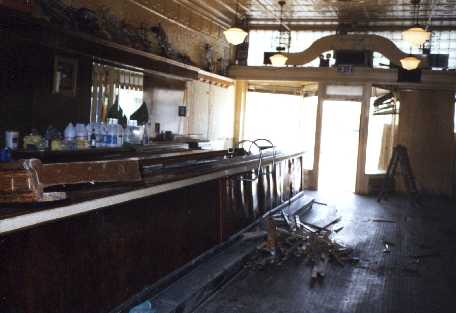
Photo from Northwest Minnesota Historical Center flood collection.
Can another flood like that of 1997 occur? Can we do anything to prevent the same kind of destruction in another such flood? These questions have become topics of discussion and debate in the Valley. Everything from larger dikes to a diversion system to better water management has been offered as a shield against "another 500 year flood." The lives and livelihoods of many hang on the outcome of these deliberations.
Whitey's tavern, a fixture in East Grand Forks, was destroyed by the flood, for not only was the building severely damaged, it stood where the planned new dike system is to be built. So the building was torn down.
Whitey's Wondrous Return
By Tammy Swift, The Forum

EAST GRAND FORKS, MN - Historic comebacks of the late 20th century: The Rat Pack. Swing. And now, Whitey's. Yes, Whitey's - the beloved watering hole of student,s construction workers and lawyers alike - has returned. Sure, it's in a different building now and the walls haven't been yellowed yet by the smoke of a million cigarettes. But the original horse-shoe bar is back, as are the black-and-white servers' uniforms, the homemade onion rings and the mirrored neon decor. So is Greg Stennes, the man behind the legend.
The sawdust had scarcely settled when Stennes hosted a soft opening for the University of North Dakota's Potato Bowl weekend September 11. A week later, he opened the restaurant for real. Its relocation to the Fail building at the corner of DeMers and 2nd Avenue Northwest is just three doors east of the previous Whitey's, which was demolished after the flood of '97.
In September, 1998, after a long wait, Whitey's reopened in a new location. Excerpt of article from the Fargo Forum, October 7, 1998.

Pictures by Jackie Lorentz, staff photographer.
In the picture above, Don and JoAnn Kuntz, owners of Fine Print, Inc., 310 Bruce Avenue, won't return to their downtown business. They support a new dike system, and they'll reopen their shop in a new location in Grand Forks. Harry Miskavige (right), East Grand Forks postmaster, want the U.S. Army Corps of Engineers to look at alternatives to the proposed dike, which he says would destroy downtown.
Dike or Diversion? Residents are Split
By Liz Fedor/ Herald Staff Writer
Grand Forks and East Grand Forks residents are evenly split about how to control the unruly Red River. A Herald poll shows that 37 percent of people surveyed want to build a dike, while 36 percent prefer a diversion channel. The U.S. Army Corps of Engineers recently proposed dike alignments that would force hundreds of homes and businesses to be demolished or relocated to make way for the new levees. But officials in both cities prodded the Corps to take a second look at a diversion channel and other flood-protection options.
"Diking will always be part of the mix," according to Robert "Punky" Beuchamp, East Grand Forks City Council president. However, he said, "Raising the bridges and relocating bridges would have a significant downgrading of river stages for The Point area (of East Grand Forks) and south Grand Forks."
After battling the worst flood of the century, local residents are searching for ways to shield themselves and their property from another devastating flood. About 70 percent of residents polled offered some support for a dike plan - 43 percent said it should be seriously considered while 28 percent said it would be that best solution. Meanwhile, 16 percent said "building a dike would be more ruinous to downtown than another flood."
The future of Greater Grand Forks will be dramatically influenced by the decisions elected leaders make about a permanent flood-protection system. The issue is a hot topic of conversation in restaurants, bars, homes and town meetings.
Don and JoAnn Kuntz, Grand Forks print shop owners, and Harry Miskavige, East Grand Forks postmaster, personify the conflicting advice that council members are hearing. The Kuntzes got four feet of water on the main floor of their business at 310 Bruce Avenue in Grand Forks. They want to move ahead with building a dike. "I saw what was inside our shop," Don said, "I don't care to deal with it again. I'd like to see it done as quickly as possible and get on with life."
Miskavige's basement at 246 Northridge Hills Court, Grand Forks, was filled with seven feet of water, and the flood came to within an inch of spilling onto the main floor of the downtown East Grand Forks post office. If the current dike alignments are approved, Miskavige would see dikes when he looks out his home and office windows. He's fighting for alternatives to the Grand Forks and East Grand Forks dike plans. "I don't want the guts of both cities ripped out," Miskavige said. "We don't have to destroy our towns."
The cities of Grand Forks and East Grand Forks have settled on higher dikes for future flood protection. But some still feel that a diversion system, like that in Manitoba, would be a better protection against high water in the future. The debate over "dike vs. diversion" divided both communities for a time. Excerpt of article from the Grand Forks Herald, May 27, 1997.
Still here, feeling even better
A year later, Grand Forks and East Grand Forks residents continue progress in personal recoveries.
Which best describes your personal recovery during the flood?
Better off then before - 5.6%
Fully recovered and life is back to normal - 39.2%
Mostly recovered, but have a few details to attend to - 24.8%
Well along in recovery, still have a lot of work to do - 16.5%
Able to put some of life back together, questions remain - 7.1%
Able to make little progress toward rebuilding life I knew - 5.1%
Not sure/no response - 1.8%
TOTAL RESPONSES - 395
Do you think you will be living here a year from now?
Yes - 85.1%
No - 8.7%
Not sure/no response - 6.2%
TOTAL RESPONSES: 404
Do you think you will be living here five years from now?
Yes - 72.4%
No - 14%
Not sure/no response - 13.7%
TOTAL RESPONSES: 344
What percentage of your friends or acquaintances have moved away?
None - 43.1%
1-5 - 41.3%
6-10 - 7.4%
11-15 - 2%
16-20 - 1.5%
More than 25 - 2.2%
Not sure/no response - 2.5%
TOTAL RESPONSES: 404
(Excerpts from poll published by the Grand Forks Herald, April 19, 1998.)
1897 flood in the Red River Valley
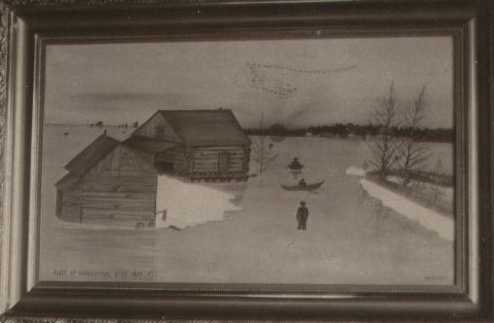
The detail was taken from the photograph below, in the collections of the Northwest Center.
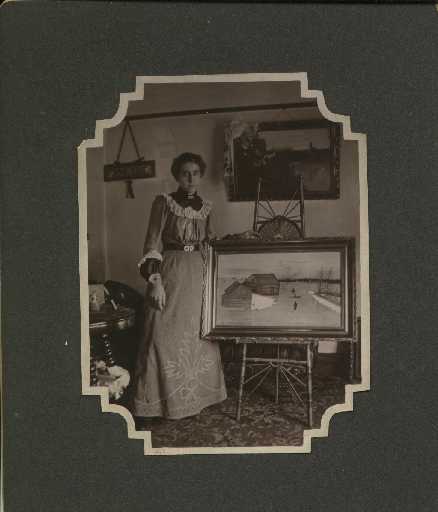
Taken in Georgetown, Minnesota, in 1902, the photograph is of Anne Stein, a local Georgetown artist.
The oil painting is of the 1897 flood in the Valley, showing a farm surrounded by water. Note the flock of birds in the sky and the small boats on the water. The painting in the photograph is part of the collections at Clay County Historical Society, Moorhead, Minnesota.
This exhibit was developed at the Northwest Minnesota Historical Center by four students of Minnesota State University Moorhead:
- Patrick Carpenter
- Jolynn Fiborg
- Jennifer Gale
- Sarah Phillips
Additional assistance was provided by:
- Terry Shoptaugh, NMHC Archivist
- Korella Selzler, NMHC Assistant
- Jody Bendel, MSU Graphic Arts Specialist
- Gretchen Gad Fournier, Lake Agassiz Regional Library Public Information Officer
The Northwest Minnesota Historical Center is located in Livingston Lord Library on the campus of Minnesota State University Moorhead.
"Ebb Tide" was funded by grants from the Dille Excellence Fund of Minnesota State University Moorhead, and the Minnesota Humanities Commission, in cooperation with the National Endowment for the Humanities and the Minnesota State Legislature.
The Lake Agassiz Regional Library serves the residents of Becker, Clay, Clearwater, Mahnomen, Norman, Polk, and Wilkin Counties with local public libraries located in Ada, Bagley, Barnesville, Breckenridge, Climax, Crookston, Detroit Lakes, Fertile, Fosston, Hawley, Mahnomen, McIntosh and Moorhead, along with the Mobile Library.
